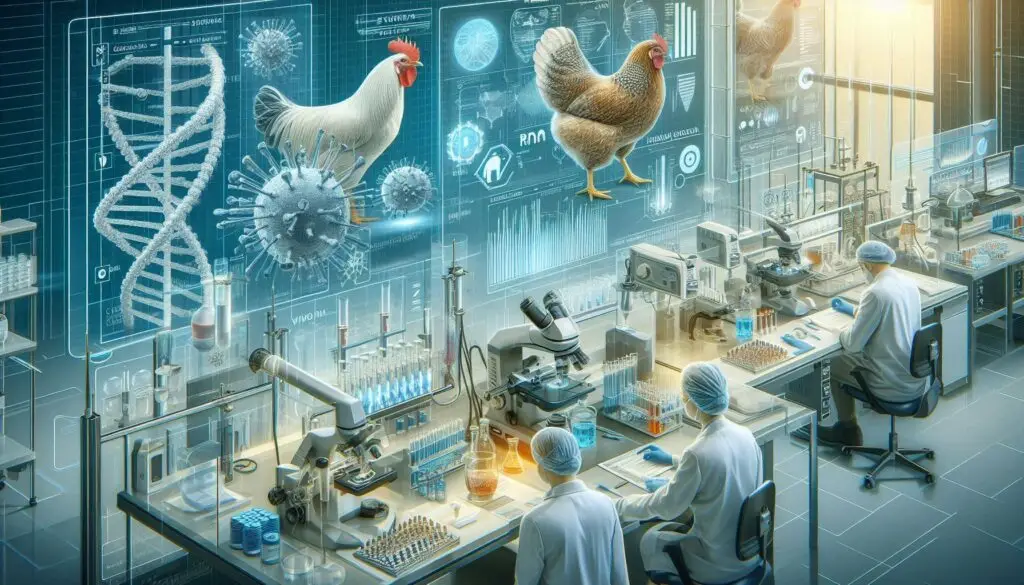Current Advances in RNA Vaccines for Poultry

Introduction
RNA vaccines are transforming the poultry industry by offering faster, more adaptable solutions to emerging diseases. Unlike traditional vaccines, RNA vaccines use genetic instructions to trigger an immune response. This method speeds up vaccine development and enhances protection against evolving viruses.
One of the best aspects of RNA vaccines is their adaptability. Scientists can rapidly adjust them to counter new virus strains. According to the USDA, RNA vaccine technology is a breakthrough for animal health, including poultry.
Understanding RNA Vaccines in Poultry
How RNA Vaccines Work
RNA vaccines contain messenger RNA (mRNA) or self-amplifying RNA (saRNA) that instructs cells to produce antigens. The immune system recognizes these antigens and develops a protective response. This approach eliminates the need to use live or inactivated pathogens in vaccine production.
Types of RNA Vaccines for Poultry
Self-Amplifying RNA (saRNA) Vaccines
- saRNA vaccines include extra sequences that allow them to replicate inside cells, producing more antigen with smaller doses.
- These vaccines require lower doses, reducing production costs. Recent research by The Pirbright Institute highlights the potential of saRNA in controlling avian influenza.
mRNA Vaccines
- mRNA vaccines provide direct instructions for antigen production but do not self-replicate.
- They generate strong immune responses, making them effective for poultry disease control.
Key Advances in RNA Vaccine Production
Rapid Customization and Development
RNA vaccines can be designed and produced in weeks. This speed allows scientists to respond quickly to emerging poultry diseases. A study published in Nature Biotechnology confirms that mRNA vaccines can be modified swiftly to combat virus mutations.
Enhanced Delivery Systems
Lipid Nanoparticle (LNP) Technology
- LNPs protect fragile RNA molecules and improve delivery into poultry cells.
- LNPs increase vaccine stability and effectiveness. According to a study by ScienceDirect, LNP-based RNA vaccines show great promise for veterinary applications.
Polymer-Based Carriers
- Researchers are exploring polymer-based carriers like chitosan for vaccine delivery.
- These materials offer cost-effective, biodegradable alternatives to LNPs.
Administration Methods for Poultry RNA Vaccines
In Ovo Vaccination
- Vaccines are injected into eggs before hatching, ensuring early protection.
- This method improves disease resistance and survival rates. The World Organisation for Animal Health supports in ovo vaccine research for global poultry health.
Spray Vaccination
- RNA vaccines are being adapted for spray administration, allowing mass poultry immunization.
- Spray vaccines simplify the vaccination process and reduce labor costs. A report from Wageningen University emphasizes the potential of aerosol-based poultry immunization.
Challenges and Solutions in RNA Vaccine Adoption
Overcoming Storage Limitations
RNA vaccines often require cold storage. However, new freeze-drying techniques are improving their stability. Experts at MIT are working on lyophilization methods to extend vaccine shelf life.
Cost Reduction Strategies
- Scaling up production and optimizing formulations will lower costs.
- saRNA vaccines reduce the required dosage, making them more affordable.
Regulatory Approvals and Safety Testing
Regulatory agencies are fast-tracking RNA vaccine approvals for poultry. Field trials are underway to ensure safety and effectiveness. According to the European Medicines Agency (EMA), RNA vaccines hold great potential for future livestock health programs.
Future of RNA Vaccines in Poultry
CRISPR and RNA-Editing Innovations
- CRISPR technology may further improve RNA vaccines by targeting specific poultry disease strains.
- Precision-based vaccine development will enhance immunity and reduce side effects.
Broader Adoption in Poultry Farming
As production costs decrease, RNA vaccines will become a staple in poultry farming. Widespread adoption can significantly reduce the spread of avian diseases.
Conclusion
RNA vaccines are revolutionizing poultry disease prevention. Their speed, adaptability, and efficiency make them a game-changer for poultry farmers. As research advances, RNA vaccine technology will continue to shape the future of poultry immunization.
For more information on RNA vaccines, visit The Pirbright Institute, USDA, or WOAH.
For more pearls of Vets Wisdom:
Azoturia in Horses






Responses